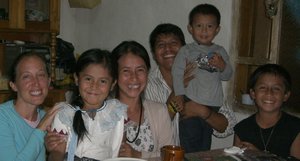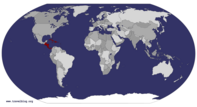Advertisement
Published: December 31st 2008

 San Pedro Homestay Family
San Pedro Homestay Family
Elena, Lorenzo, little Lorenzo, and FranciscoWelcome to everyone who is interested in hearing about my year and a half traveling and staying put, in various countries. This is written to fulfill a promise to share some travel photos and stories.
Markets, indigenous people, and traditional clothing in Guatemala: Guatemala has a strong indigenous culture, with 21 Mayan languages still spoken and distinct indigenous clothing, cultures, and religious practices. The rural areas of the country have the highest concentrations of indigenous people, and are the poorest and least developed in terms of electricity, sewage, and potable water. Indigenous people and the rural areas where they live have low literacy rates. The good news is that the United Nations Human Development Index has been steadily improving in Guatemala - literacy, clean drinking water access, and rates of death from preventable diseases are all improving. Most of the indigenous people (men included) are my height or smaller, and in the USA I am a small woman. Some of the indigenous men carry heavy loads of produce on their backs, with a strap going around their forehead to balance the load. Quite a few of men at the markets move nearly doubled over, with their huge loads. Some of
the older men in rural villages wear traditional dress: a small brimmed hat, and pants that look like culottes with a specific design depending on their home region. They wear a belt that wraps around and is tied. Most of the men wear western-style clothes, however. Many indigenous men and boys wear a 'gold' (not real) decoration on a couple of their teeth. The majority of the women wear 'traditional' clothing - a skirt made of a rectangle of fabric that wraps around, with designs according to their home region. The skirt is belted with a long strip of fabric heavily designed with stitching or beads. They generally wear a short-sleeved blouse on top. Women have infants on their backs, tied with a long strip of fabric the mother knots in front. The kids are totally cute, looking interestedly at the world over their mother's shoulder. Children here seem to cry much less than in the U.S., maybe because of the constant body contact and seeing interesting things. Women carry loads on their heads - huge heavy baskets of produce, cakes for sale, or even a bag of just a few oranges. Some of the women wear their hair in

 Spanish class in garden
Spanish class in garden
Total immersion: Class half the day, followed by homework and home stay. two long braids, with a single ribbon of fabric braided through both, and large bows at each end. Others wrap their hair in an extremely long band, then loop their hair and the band around their head, ending in a decorative knot with tassels. Specific designs depend on their regions, but all are brightly colored and some with shiny metallic fabrics. Women wear aprons - long frilly aprons that reach just above their ankle-length skirt. At the market, they wear an additional lacy multipocketed apron that is much shorter, and they keep their change there. Traditional clothing has changed over time, and I am curious how the aprons became part of the go-everywhere attire.
Some Google Image photos (not mine) of indigenous clothing still commonly worn in Guatemala. Cellphones: Everybody in Guatemala has one. The contrast between old and new is striking, when an indigenous woman in full traditional garb, a baby tied in cloth on her back, and carrying a heavy load on her head reaches into her traditional apron to answer her cellphone.
Guatemala transportation To get around, I mostly took chicken buses (ex-schoolbus from the US, painted with designs in bright colors), occasionally within town a micro (a small van jam-packed with about 30 people), and other times

 Cornfield view
Cornfield view
Another beautiful view in San Pedroa pickup truck with rails high around the back (where you stand and get fresh air and excellent views). When I lived in Xela, I also rode my bicycle.
Chickenbuses Here are a bunch of Google Image Search photos (not mine) of the buses. There doesn't seem to be a definition of 'too full' for chicken buses. I've usually been one of few non-Guatemalans on the bus, when I take one. The roof rack usually has loads of produce, furniture, and occasionally livestock. A 3-hour ride costs about 20Q (~$3). Chickenbus drivers often chose to go around blind corners by speeding on the left (wrong) side of the highway and beeping. Sometimes there was a truck filled with huge boulders on the same side coming towards us, a rock slide, or a small vehicle, and the driver swerved at the last minute and miss it. The whole while, the driver's helper ('ayudante') might be halfway hanging out the open doorway, shouting the names of the next few pueblos the bus is headed towards when potential passengers were spotted. Bus rides in general were quite eventful in Guatemala, beyond just being packed and having drivers with nerves of steel. Traveling salespeople board and loudly proclaim the benefits of their medicines, or vend their

 Lake Atitlan
Lake Atitlan
Peaceful morning viewbaked goods and candies. Preachers board and loudly proclaim to the bus for a couple of stops, then collect funds and wait for a bus going the other direction. Buses are a great way to get around the country cheaply, and to experience travel the way Guatemalans experience it.
Guatemala City:
Flew into here, and took a city bus into the inexpensive hostel zone. I walked around a lot during the days, and turned in early at night. In addition to a lot of automotive traffic, street traffic included people pushing carts and one person on the sidewalk with a herd of goats and a bullwhip.
Antigua: Antigua has colorful buildings, unusually well-maintained and perpendicular roads and sidewalks, and a large variety of language schools, restaurants, and tourists. The market here is large and colorful.
Markets are noisy, with bartering and sellers vying for customers. A lot of children work, instead of going to school. In Antigua, you see many other schoolchildren in their uniforms. The kids working at the market have much more worn-looking clothes, and many children are thin.
San Pedro La Laguna: I did 5 weeks of a homestay and language school (http://cooperativeschoolsanpedro.com/) in

 La Puerta restaurant view
La Puerta restaurant view
San Pedro volcano one side, lake in frontSan Pedro. The family I stayed with was lovely. 2 and 1/2 year old Lorenzo immediately made me feel at home, by helping me to unpack (and repack, and unpack, and repeat...). He daily visited me for 'reading' my travel guide pictures, ball throwing games, and the always-fascinating game of unpack/repack the small toiletries bag. What a cutie! I had a gorgeous view from my bedroom window - just below me, chickens running free in the family yard below, then the sloping view of all of San Pedro down to the lake, and finally the whole lake and all the mountains around it. Sunrise was beautiful from my room.
Most of the time, the family has a student staying with them. It must take a lot of tolerance on their part, sharing 3 meals a day with a foreigner who struggles with the language. For their part, their first language is the Mayan language Tzu'tuil, and their second is Spanish. They mostly spoke Spanish around me, but sometimes I heard the clicks and guttural sounds unique to Tzu'tuil. There is a Tzu'tuil cable TV station in the area, an important means of mass communication to a people with a low

 Street signs in San Pedro
Street signs in San Pedro
No signs on poles, but painted signs will get you to your restaurant or schoolliteracy rate (especially the older Tzu'tuil-only speakers).
The two older kids go to school 4 hours each day, at the public school. My Spanish teacher, Antonio, had to leave his family and live in Guatemala City to go to high school. Luckily for my family, San Pedro now has a high school.
Loud firecrackers are set off most mornings around 5AM, and echo across the lake. They are used at people's homes to celebrate birthdays, religious holidays, and anniversaries. I have decided I don't like firecrackers.
Kids here love kites, and in the afternoons the skies are full of them. Most electrical and phone wires have pieces of kites fluttering off them. Kites fly amazingly high here, a testament both to the kids' skill and the strong afternoon winds. I imagine the potential energy from windmills is great on these mountains. However, deforestation has led to deadly mudslides on the slopes, and the windmills would need stable mounting. (People gather wood for fires for cooking, and the increasing population causes increasing deforestation.)
My favorite weekend San Pedro activities were kayaking in the lake, and reading or chatting with friends at the beautiful La Puerta cafe.

 Kayaking Lake Atitlan
Kayaking Lake Atitlan
One of my favorite weekend activities. Some steep farm plots visible, common around the lake.Monday-Friday, Spanish classes were 8AM-12PM. They are one-on-one, at tables scattered throughout the school's hilltop garden. The view is superb - lake, volcanic mountains, and pretty flowers and trees all around. It smells fresh and sweet from the garden, and there are butterflies and colorful birds all around. Class was hard work, and we had homework as well as studying to do every night. In addition to Spanish lessons, they have cultural events most nights: documentary films about Central American history, salsa dance classes, and lectures on Mayan culture. My teacher Antonio was knowledgeable and patient, and luckily we found enough to talk about, to fill 4 hours a day for five full weeks.
Here is my Spanish school's official website Most streets in San Pedro don't have street name signs, and the way to get somewhere often includes a dirt path through a small cornfield. Street and path intersections often have brightly painted signs with an arrow pointing the way to various destinations.
The San Pedro Volcano hike was excellent exercise. It involved about 4.5 hours of steep fast uphill hiking and 2.5 hours to come back downhill. Views are gorgeous, and the hike goes through a pretty little coffee farm before reaching

 Solar heated hot tubs of San Pedro
Solar heated hot tubs of San Pedro
The black coils of water absorb solar energy.the first treeline. My group was composed of a guide, 4 just-graduated-from-med-school doctors, and me. The four doctors were daily joggers, and just generally high-energy go-getters. These impressive women not only hiked fast without seeming to exert themselves at all... but, the whole time up and down, they conjugated Spanish verbs. Also, when I felt a blister starting, they treated me by wrapping the area in duct tape! worked great- no more pain and a blister never developed. After hiking, I met up with friends from school and we went to the solar-heated hot tubs, with a carton of red wine. Ideal way to end a hike.
Advertisement
Tot: 0.105s; Tpl: 0.011s; cc: 7; qc: 45; dbt: 0.0408s; 1; m:domysql w:travelblog (10.17.0.13); sld: 1;
; mem: 1.1mb









